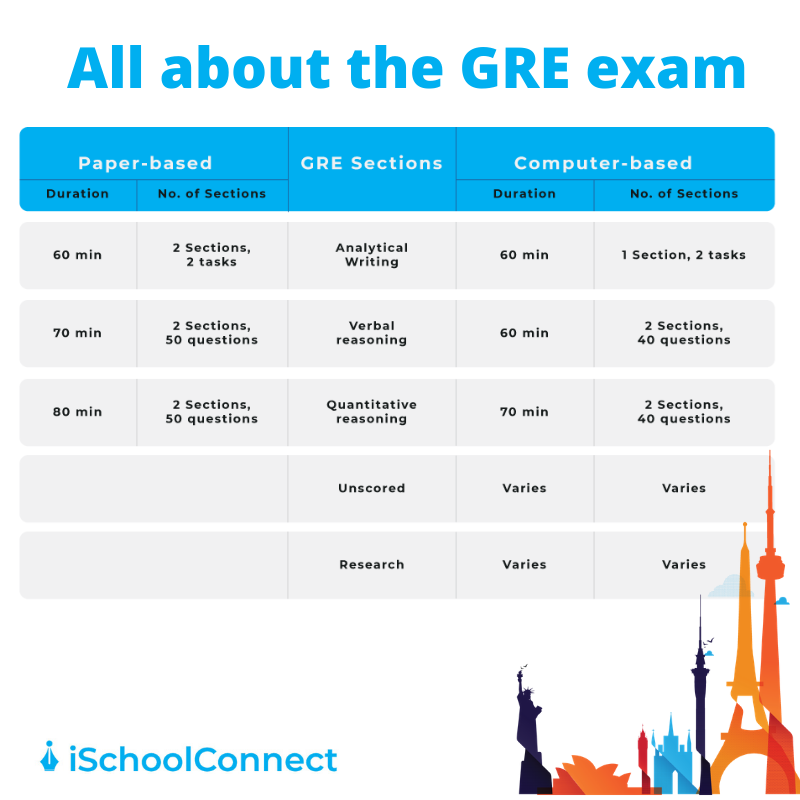Table of Contents
The GRE (Graduate Record Examination) is a multiple-choice, standardized test conducted by ETS. Universities use the GRE exam scores of applicants to gauge their preparedness for graduate programs. Although these scores only form one part of your application profile, you should consider taking the exam seriously. This is because colleges use GRE scores as a benchmark to filter through their list of applicants. Think there’s a lot more you don’t know yet? This blog covers everything you need to know – from registration and test experience to exam tips and taking the GRE sample test. Read on!
Check These Also | |
| IELTS Practice Tests | TOEFL Practice Test |
| PTE Practice Tests | GMAT Practice Test |
What is GRE?
It’s common for students to scratch their heads and wonder what GRE is. For starters, it’s a broad-based assessment of a student’s aptitude. The exam measures a student’s skills in essay evaluation, critical thinking, analytical writing, and problem-solving. More importantly, the test assesses how you manage time and the way you work under stress. This is why it’s globally accepted as a good measure of a student’s aptitude and readiness for a graduate-level program. Consequently, more than half a million students take the test every year before applying.
GRE Exam Pattern
The GRE exam, also known as the General Test, lasts for an average duration of 3 hours 40 minutes. It is divided into 3 main sections: Analytical Writing, Verbal Section, and Quantitative Reasoning. Apart from these, there is also one Unscored and Research section, which ETS does not count in the actual GRE exam score. This section is variable in nature, i.e., it can either be quantitative or verbal.
The GRE sample test papers can give you a detailed idea about the exam pattern and how to attempt different sections.
Here’s a breakdown of the entire GRE exam pattern 2024:

GRE Exam Pattern Changes for 2024
From 22nd September 2023, a new shorter format for the GRE tests is being introduced. This format will continue to test the verbal and quantitative reasoning skills, critical thinking, and analytical skills of the applicant. The duration of the GRE is the most significant change being made to the new format. The exam which was previously 3 hours and 45 minutes long will be reduced to 1 hour and 58 minutes long. There will be a change in the overall structure of the exam.
Section | Structure | Questions | Time estimated |
Analytical writing | 1 section | 1 essay | 30 mins |
Quantitative reasoning | 2 sections | 27 questions | 47 mins |
Verbal reasoning | 2 sections | 27 questions | 41 mins |
The waiting time for GRE test scores has also been reduced and students can expect their results in a period of 8-10 days. It previously took 10-15 days to get the scores. The ETS will announce practice tests of 2 hours in the month of September.
The questions being removed from the 2023 test pattern is:
- Argumentative essay
- Experimental or uncensored section.
- Reduction of questions from 40 to 27 in the Quantitative and Verbal sections.
- Removal of the 10-minute break.
How do I register for GRE?
The registration process for GRE is pretty straightforward. First, create an account on the ETS website. To register online, go to “My GRE Home” page, select “Register”, and then “Find Test Centers.” Note that ETS administers the GRE at Prometric test centers. Pay the registration fee for the exam, which is $205, and there you are! You’ll receive a confirmation email from ETS regarding your test date and time.
At a later stage, if you want to change the test center, or reschedule your test, it can cost you an extra $50. ETS offers fee reductions to students who prove their financial hardship.
For cancellation, ETS asks that you cancel your exam at least 4 days in advance so you can get a partial refund.
If you are looking for a GRE sample test, you can find some on this website.
How is the GRE Test Conducted?
ETS administers the GRE in 2 ways. There is a Paper-delivered test with a total test of 3 hours and 30 minutes and a Computer-delivered test with a total time of 3 hours and 45 minutes. Paper-delivered tests are rare and are conducted only thrice a year. But you can register for the computer-delivered tests at any time of the year. The computer-delivered test is section-adaptive. This means that the computer selects the next section of your exam based on your performance in the previous section.
Check Out These Related Blogs
GRE Exam Dates 2024

As is the case with other entrance exams (like the IELTS), there are no fixed GRE exam dates. You can decide to apply for the GRE test at any time of the year. All you have to do is to choose which mode of examination you want to attempt and choose the test centers for the Computer-delivered test or Paper-delivered test.
It is important to promptly book an appointment at the GRE test center of your choice. There is a possibility that you might not get the date or center you want due to a lack of free slots. In this case, you might have to travel farther to give the exam. So make sure you take a look at the GRE test centers in advance and book your GRE test dates according to the seat availability.
How is the GRE Exam Scored?
As we mentioned earlier, the exam comprises three main sections: Analytical Writing, Verbal Section, and Quantitative Reasoning. The Quantitative and Verbal sections are graded on a scale of 130-170 each, whereas analytical writing scores range between 0-6. Some colleges require additional test sections to be taken with the GRE test, but they’re not graded in the final score of the test. So, your GRE test score will be out of 340 marks, and it’ll stay valid for 5 years.
GRE Exam Syllabus
Each section of the GRE will challenge your reasoning and problem-solving skills differently. Let’s look at them one by one. You can know more about the syllabus and the pattern by taking a GRE sample test.
Analytical Writing
This section examines your ability to interpret and express your thoughts on complex issues and arguments.
The first task is “Analyze an Issue”, where you will be given an opinion on a topic of general interest. Once you’ve understood the pros and cons of the opinion, things become easy. All you have to do is support your argument well.
The second task is to “Analyze an Argument”. Here, you’ll have to look at the two sides of an argument. Then, you’ll have to a side and strengthen your argument accordingly.
Verbal Section
In these sections, you are asked to understand the written content and answer queries accordingly.
You’ll encounter 10 Reading Comprehension questions that will assess your ability to read and understand a passage.
There will be 6 Text Completion and 4 Sentence Equivalent questions. These questions test your vocabulary and your ability to understand the context of a sentence.
Quantitative Reasoning
This section analyzes your problem-solving skills and basic mathematical concepts such as Algebra, Geometry, Data analysis, etc.
In this section, you’ll encounter 7-8 Quantitative Comparison questions, which will test your problem-solving speed.
The second kind of questions you’ll encounter are Problem Solving questions. Here, you have to correctly understand the context and gather the needed data. It assesses your ability to think laterally.
How much should your GRE Score be?
The importance of your GRE score varies depending on the institution and degree program. Some programs may consider your test score to be a critical determinant for your admission while others may only consider it a formality. But most institutions have their own formula for incorporating your GRE test scores in their selection process.
The average GRE scores are-
- Verbal and Quantitative sections – 150-155 (Range 130-170)
- Analytical section – 3.5 (Range 0-6)
Book to Help You Prepare for GRE
Here are some books that can help you kick start your GRE prep:
- Manhattan Prep’s 5 lb. Book of GRE Practice Problems, 3rd Edition
- The Official GRE Super Power Pack, 2nd Edition
- GRE Prep by Magoosh
- Test Prep Books’ GRE Prep, 2021 and 2022
- Manhattan Prep’s GRE Strategy Guides
GRE Sample Test Papers
Attempting a GRE sample test is the best way to see where you stand with your GRE scores. This will give you a clear idea of what sections and question types you need to improve on.
GRE is certainly one of the important steps for your graduate studies. We hope this article has helped you in clearing all the doubts about the GRE test. Check out our other blogs on the most preferred universities by Indian students, myths students have about studying abroad, New York University, and many more. Connect with us over a call or drop a mail to know more.
Key Takeaways
- The GRE test can be taken in any month depending on the state you live in.
- The first step to begin your test prep is to know the GRE exam syllabus and the test structure. You can also refer to previous years’ papers to get an idea about the format of the exam.
- Try and have a fixed study schedule. It will help you streamline your preparation and enhance your productivity.
- Don’t be afraid of taking the GRE sample test. Take as many mock tests as you can as it will help you identify your weaknesses. You can also tweak your strategies by analyzing what’s working for you and what’s not.
The changes in the GRE test pattern made for 2023 is beneficial for students as they can not only get their results sooner, but also have higher chances of passing the exams. Hope all your GRE exam related questions have been answered. If you need more assistance click here to contact us.
Liked this blog? Read next: How to Score 170 in GRE Math | Syllabus, tips, and more!
FAQs
Q1. Who is eligible for taking the GRE exam?
Answer- While there are no basic eligibility criteria regarding age or grade, the applicants must have a valid passport to appear for the exam.
Q2. How often can I retake the GRE test?
Answer- The test can be taken once every 21 days up to 5 times. Remember, it must be in the continuous rolling 12-months period.
Q3. What is the validity of GRE scores?
Answers- Your GRE scores are valid for five years.







Really loved the words